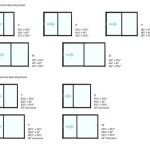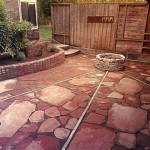Beautiful Patio Pavers: Enhancing Outdoor Living Spaces
Patio pavers represent a versatile and aesthetically pleasing solution for creating durable and attractive outdoor living spaces. The selection of appropriate pavers can significantly enhance the functionality and visual appeal of a patio, transforming it into an extension of the home and a focal point for relaxation and entertainment. This article will explore the various aspects of patio pavers, including their types, benefits, installation considerations, and maintenance requirements.
The term "patio pavers" encompasses a wide range of materials specifically designed for creating paved surfaces intended for pedestrian traffic and outdoor use. These materials are typically manufactured with properties that ensure durability, weather resistance, and slip resistance. The diversity in styles, colors, shapes, and textures allows homeowners to customize their patios to match their architectural style and personal preferences.
Types of Patio Pavers
The market offers a diverse array of patio paver materials, each possessing unique characteristics that make them suitable for different applications and design aesthetics. Understanding the properties of each material is crucial for making an informed decision.
Concrete Pavers: Concrete pavers are one of the most popular choices due to their affordability, versatility, and durability. Manufactured from a mixture of cement, aggregates, and pigments, these pavers can be molded into various shapes, sizes, and colors. Concrete pavers are generally resistant to cracking and can withstand heavy loads, making them suitable for high-traffic areas. They are also relatively easy to install and maintain.
Variations in concrete pavers include permeable pavers, which are designed to allow water to drain through the surface, reducing runoff and promoting groundwater recharge. Other variations offer textured surfaces that mimic natural stone or brick. The cost-effectiveness of concrete pavers, coupled with their extensive design options, makes them an attractive choice for many homeowners.
Brick Pavers: Brick pavers offer a classic and timeless aesthetic, adding character and warmth to any outdoor space. Manufactured from clay that is fired at high temperatures, brick pavers are known for their durability and resistance to weathering. They possess a natural reddish-brown hue, although variations in color are available depending on the clay composition and firing process. Brick pavers are typically laid in traditional patterns such as herringbone or running bond, creating visually appealing surfaces.
While brick pavers are more expensive than concrete pavers, their longevity and aesthetic appeal often justify the cost. Their porous nature allows for good drainage, and they are resistant to fading and staining. Brick pavers require minimal maintenance and can last for decades with proper care.
Natural Stone Pavers: Natural stone pavers offer a premium and luxurious look, showcasing the unique beauty and character of natural materials. Common types of natural stone used for pavers include flagstone, slate, travertine, and granite. Each type of stone possesses distinct characteristics in terms of color, texture, and pattern. Flagstone pavers, for example, are known for their irregular shapes and natural cleft surfaces, creating a rustic and organic feel.
Natural stone pavers are highly durable and resistant to weathering, making them suitable for harsh climates. However, they are typically more expensive than concrete or brick pavers. Installation requires specialized skills and equipment due to the varying thicknesses and shapes of the stones. The beauty and natural variation of natural stone pavers make them a coveted choice for high-end patio designs.
Porcelain Pavers: Porcelain pavers are a relatively new option in the paving market, gaining popularity for their exceptional durability, low maintenance, and sophisticated appearance. Manufactured from high-density ceramic materials, porcelain pavers are resistant to staining, fading, and scratching. They are also frost-resistant and suitable for both indoor and outdoor applications. Porcelain pavers are available in a wide range of colors, patterns, and textures, including options that mimic natural stone or wood.
The key advantage of porcelain pavers is their low porosity, which prevents water absorption and reduces the risk of cracking or damage from freezing temperatures. They are also lightweight and easy to install, making them a versatile choice for various patio designs. While porcelain pavers are typically more expensive than concrete pavers, their long-term durability and minimal maintenance requirements make them a cost-effective option in the long run.
Benefits of Using Patio Pavers
The advantages of using patio pavers extend beyond aesthetics, encompassing practical considerations such as durability, maintenance, and cost-effectiveness. Pavers offer a range of benefits that make them a superior choice compared to other paving materials like poured concrete or asphalt.
Durability and Longevity: Patio pavers are designed to withstand heavy loads and resist cracking, weathering, and erosion. Unlike poured concrete, which is prone to cracking over time due to temperature fluctuations and ground movement, pavers are individual units that can shift and adjust without compromising the structural integrity of the entire surface. This flexibility allows pavers to last for decades with proper installation and maintenance.
The interlocking nature of paver systems further enhances their durability by distributing weight evenly across the surface. This reduces the risk of individual pavers sinking or shifting, creating a stable and long-lasting patio surface.
Low Maintenance: Patio pavers require minimal maintenance compared to other paving materials. Regular sweeping and occasional washing with soap and water are typically sufficient to keep pavers looking their best. Unlike poured concrete, which may require sealing or resurfacing to prevent staining and cracking, pavers are naturally resistant to staining and can be easily replaced if damaged.
The interlocking design of paver systems also helps to prevent weed growth by minimizing gaps between pavers. This reduces the need for frequent weeding or the use of herbicides, contributing to a low-maintenance patio surface.
Design Versatility: Patio pavers offer unparalleled design versatility, allowing homeowners to create custom patios that reflect their personal style and complement their home's architecture. Pavers are available in a wide range of colors, shapes, sizes, and textures, providing endless design possibilities. They can be arranged in various patterns, such as herringbone, running bond, or basket weave, to create visually appealing surfaces.
The modular nature of pavers also allows for easy incorporation of curves, borders, and other design elements. This flexibility makes pavers an ideal choice for creating unique and personalized outdoor living spaces.
Cost-Effectiveness: While the initial cost of installing patio pavers may be higher than other paving materials, their long-term durability and low maintenance requirements make them a cost-effective option in the long run. Pavers typically last for decades with minimal repairs, reducing the overall cost of ownership. Their resistance to cracking and staining also eliminates the need for costly repairs or resurfacing.
Additionally, the ease of installation and replacement of individual pavers can save on labor costs compared to repairing or replacing large sections of poured concrete or asphalt. The long-term value and benefits of patio pavers make them a worthwhile investment for any homeowner.
Installation Considerations for Patio Pavers
Proper installation is crucial to ensuring the longevity and performance of patio pavers. A well-installed paver patio will provide a stable, durable, and visually appealing surface for years to come. The installation process involves several key steps, including site preparation, base construction, paver placement, and joint filling.
Site Preparation: The first step in the installation process is to prepare the site by removing any existing vegetation, topsoil, and debris. The area should be excavated to a depth that allows for the proper base construction and paver thickness. The subgrade should be compacted to create a stable foundation for the base material.
Proper grading and drainage are essential to prevent water from pooling on the patio surface. The site should be sloped away from the house to ensure that water drains away effectively. If necessary, a drainage system may need to be installed to manage water runoff.
Base Construction: The base is a critical component of a paver patio, providing a stable and load-bearing foundation for the pavers. The base typically consists of a layer of compacted gravel or crushed stone, followed by a layer of sand. The gravel or crushed stone layer provides drainage and support, while the sand layer provides a smooth and level surface for the pavers.
The thickness of the base layer depends on the soil conditions and the anticipated load on the patio surface. In areas with poor soil drainage, a thicker base layer may be required. The base material should be compacted thoroughly using a plate compactor to ensure stability and prevent settling.
Paver Placement: Once the base is prepared, the pavers can be placed according to the desired pattern and design. Pavers should be laid tightly together, with minimal gaps between them. A rubber mallet can be used to gently tap the pavers into place and ensure that they are level. It is important to maintain consistent spacing between pavers to create a uniform and aesthetically pleasing surface.
Cutting pavers may be necessary to fit around edges, corners, and other obstructions. A paver splitter or masonry saw can be used to cut pavers accurately and cleanly. Safety precautions should be taken when using power tools, including wearing safety glasses and gloves.
Joint Filling: After the pavers are placed, the joints between them need to be filled with sand or polymeric sand. Sand helps to lock the pavers together and prevent movement. Polymeric sand is a specialized type of sand that contains additives that bind the sand particles together, creating a more stable and durable joint filling.
The sand or polymeric sand should be swept into the joints using a broom. A plate compactor can be used to compact the sand and ensure that it is evenly distributed. Excess sand should be removed from the paver surface to prevent staining or discoloration. Proper joint filling is essential to maintaining the stability and integrity of the paver patio.

Planning For A Paver Patio Ideas And Inspiration Town Country Living

Paver Patio Ideas 5 Inspirational Designs For Comfortable Outdoor Living Leave Your Mark Llc

Paver Patio Ideas 5 Inspirational Designs For Comfortable Outdoor Living Leave Your Mark Llc

40 Paver Patio Ideas To Help You Design Your Outdoor Space

Patio Pavers From System
5 Patio Designs That Wow Unilock

Landscape Design 50 Beautiful Backyard Paver Patio Ideas

Paver Patios What You Need To Know American Paving Design

Paver Patio Ideas Design Tips For Patios Unilock

Paver Patio Ideas Landscaping Network
Related Posts








